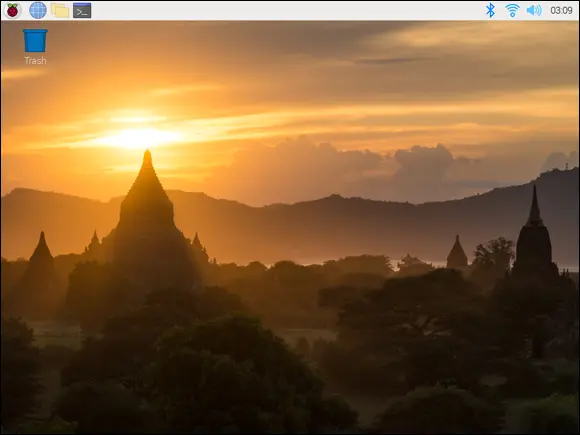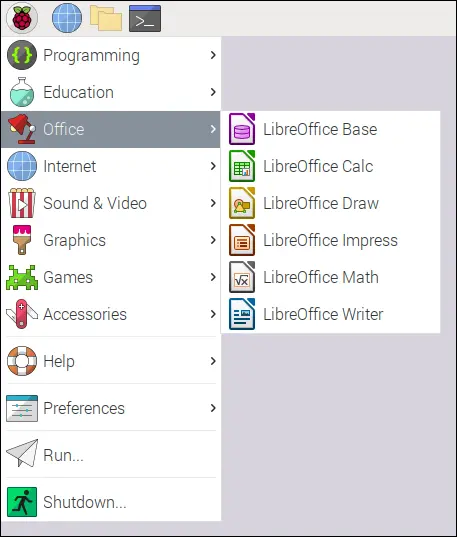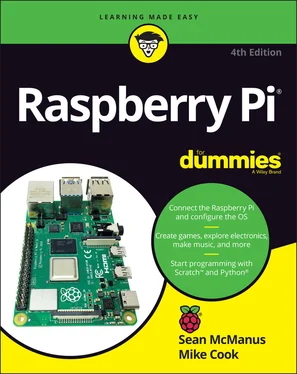 You can only use SSH to access the Raspberry Pi command line, not the desktop.
You can only use SSH to access the Raspberry Pi command line, not the desktop.
Using VNC, you can control your Raspberry Pi’s desktop environment from another computer. If you register for a RealVNC account, you can access your Raspberry Pi over the public Internet. Just follow these steps:
1 Change your password.To prevent unauthorized access to your Raspberry Pi after a remote connection is enabled, start by changing your password. You can use the Raspberry Pi Configuration tool (see “ Configuring Your Raspberry Pi in Raspberry Pi OS,” earlier in this chapter), or see Chapter 5for instructions on changing the password in the command line.
2 Enable VNC on your Pi.Use the Raspberry Pi Configuration tool to enable VNC on the Interfaces tab.
3 Get your Pi’s IP address.Click the VNC icon, which appears in the upper right of your desktop. The window that opens shows you the IP address you need to connect to your Pi.
4 Install VNC Viewer.You’ll need to install VNC Viewer on the device you want to connect from. You can download it at www.realvnc.com/en/connect/download/viewer . Apps are available for Windows, macOS, and Linux. If you want to manage one Raspberry Pi from another, there’s a version of VNC Viewer for the Raspberry Pi, too. Apps for Android and iOS are available, but they’re quite hard to use without a physical mouse and keyboard.
5 Connect from your other device.Run VNC Viewer, and you’ll be prompted to enter a VNC server address. This is the IP address displayed by your Raspberry Pi. The first time you connect, VNC Viewer warns you that it hasn’t connected to this device before. Click Continue. When you enter your username and password, a window opens that shows your Raspberry Pi screen. You can now control your Raspberry Pi remotely.
 Using VNC, you can share a keyboard and mouse between your PC and your Raspberry Pi. Connect them to your PC; then use VNC to control your Raspberry Pi from your PC.
Using VNC, you can share a keyboard and mouse between your PC and your Raspberry Pi. Connect them to your PC; then use VNC to control your Raspberry Pi from your PC.
Part 2
Getting Started with Linux
IN THIS PART …
Use the Raspberry Pi desktop to manage the files and start the programs on your Raspberry Pi.
Discover some of the games and applications provided in Raspberry Pi OS.
Surf the web and manage bookmarks for your favorite sites.
Watch slide shows with the Image Viewer and use it to rotate your photos.
Explore your Linux system and get to know the directory tree and file structure.
Back up your Raspberry Pi’s microSD card.
Use the Linux shell to organize, copy, and delete files on your microSD card, and to manage user accounts.
Use the desktop or the shell to discover, download, and install new software.
Chapter 4
Using the Desktop Environment
IN THIS CHAPTER
 Using the Raspberry Pi Desktop to manage your Raspberry Pi
Using the Raspberry Pi Desktop to manage your Raspberry Pi
 Using external storage devices in the desktop environment
Using external storage devices in the desktop environment
 Copying, moving, and managing files and their permissions
Copying, moving, and managing files and their permissions
 Viewing web pages on the Raspberry Pi
Viewing web pages on the Raspberry Pi
 Using some of the built-in applications and games on your Raspberry Pi
Using some of the built-in applications and games on your Raspberry Pi
 Customizing the desktop with your preferred settings
Customizing the desktop with your preferred settings
The quickest way to start playing with your Raspberry Pi is to use the Raspberry Pi Desktop. It works in a similar way to the Windows and macOS operating systems, which let you use icons and the mouse to find and manage files and operate applications. That makes it relatively intuitive to navigate, and it means you can easily find and try out some of the software that comes with your Linux distribution.
In this chapter, we talk you through using the desktop and introduce you to some of its programs.
Navigating the Raspberry Pi Desktop
Figure 4-1 shows the Raspberry Pi Desktop. The photo in the middle of the screen is just a wallpaper (a decorative background image on the screen), so don’t worry if you see a different image there.
 The strip along the top of the screen is called the taskbar, and this is usually visible in whatever application you’re using.
The strip along the top of the screen is called the taskbar, and this is usually visible in whatever application you’re using.

LXDE Foundation e.V. / Raspberry Pi Foundation; wallpaper photo by Greg Annandale of the Raspberry Pi Foundation
FIGURE 4-1:The Raspberry Pi Desktop.
Using the Applications menu
For most of the applications you might want to run, you use the Applications menu. At the top left of the screen is the Raspberry Pi icon. Click it and you’ll see the menu appear, similar to the one shown in Figure 4-2.
As you move the mouse cursor over the categories of applications, a submenu appears on the right, showing you the applications in that category. Click one of these once to start it.

LXDE Foundation e.V. / Raspberry Pi Foundation
FIGURE 4-2:The Applications menu.
 If you right-click an application on the menu, you can add its icon to the desktop so that you can start it more quickly in the future.
If you right-click an application on the menu, you can add its icon to the desktop so that you can start it more quickly in the future.
Buried among the submenus in the Applications menu, you’ll find a wealth of applications including the following:
Bookshelf: This app gives you access to free magazines and books from the Raspberry Pi Foundation that you can download. You’ll find it in the Help section of the Applications menu.
Claws Mail: You can use this email package for sending and receiving messages on your Raspberry Pi. We tell you more about it later in this chapter. It’s in the Internet section of the Applications menu.
Debian Reference: The Raspberry Pi OS version of Linux is a Pi-specific version of the Debian distribution, so this icon gives you a guide to using Linux on your Pi. The documentation is stored on your SD card, but appears in a web browser, like a website. To get started, click the icon and then click the HTML (Multi-Files) link at the top of the screen. You probably won’t need to use this resource often, but it’s good to know it’s there if you get stuck. To find this reference guide, go through the Help section of the Applications menu.
Читать дальше

 You can only use SSH to access the Raspberry Pi command line, not the desktop.
You can only use SSH to access the Raspberry Pi command line, not the desktop. Using VNC, you can share a keyboard and mouse between your PC and your Raspberry Pi. Connect them to your PC; then use VNC to control your Raspberry Pi from your PC.
Using VNC, you can share a keyboard and mouse between your PC and your Raspberry Pi. Connect them to your PC; then use VNC to control your Raspberry Pi from your PC. Using the Raspberry Pi Desktop to manage your Raspberry Pi
Using the Raspberry Pi Desktop to manage your Raspberry Pi












